These are the questions I am asked hundreds of times a day during the three weeks of ArtPrize. Since they are pretty consistent I thought I’d compile them together into an FAQ post. If you don’t see the origami related question you may have wondered about feel free to leave a comment and I’ll reply there or add it to the post if it’s a popular question I’d forgotten about.
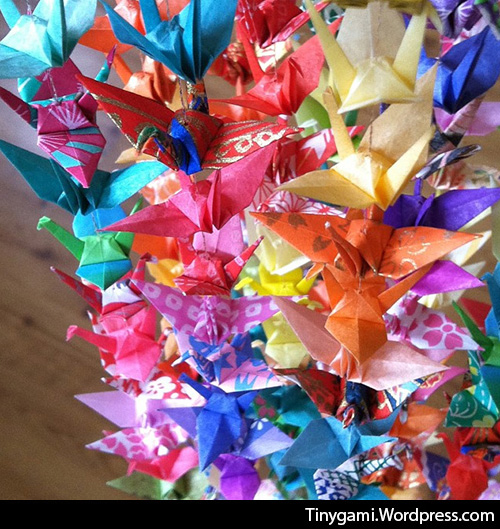
Question: Do you use tweezers or tools to fold the cranes?
Answer: No. I only use my fingers. Seriously! 🙂
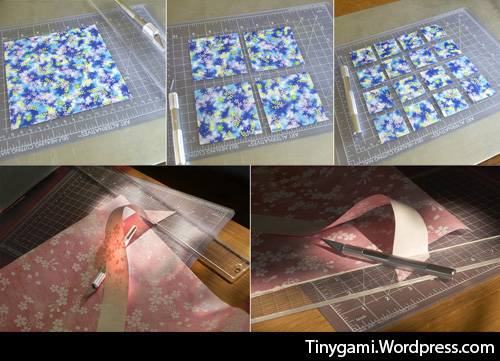
Question: How long does it take to make a mobile of 1000 cranes?
Answer: In a perfect world I’d have 3 months for each mobile. But on deadlines I can finish them faster. Steps involved include:
- Concept development
- Sourcing materials for structures
- Shopping for paper
- Cutting paper into 1000 tiny pieces with a metal straight edge and X-acto knife on a self healing cutting mat
- Folding cranes
- Building mobile structure
- Hanging mobile structures
- Dividing cranes
- Hanging cranes
- Finishing details
Question: How long does it take to fold one crane?
Answer: Just a few (2-3) minutes. But some of the thicker, softer, more fibrous papers will strain the tendon in my right forearm very quickly requiring me to take breaks every 20 minutes or so for at least that long or longer.

Question: What kind of paper do you use to make your mobiles?
Answer: Almost all of the paper is imported origami paper from Japan. There are exceptions such as the white paper in the Mochibana piece which is tracing paper because I wanted a translucent quality that evoked the translucence of mochi, the dessert made of pounded sweet rice.
When I lived in California I was able to shop at a multitude of Japanese and art paper stores to find my origami paper.
Here in MI I’ve been to Hollander’s paper store in Ann Arbor twice and have resorted to ordering online.
I also receive very generous and thoughtful gifts of paper from time to time (thank you EmiInk!). They are always the most special papers of all.
Question: Where do you buy your paper?
Answer: I’ve been collecting paper since 1995 and have accumulated what I call my “stash” that I add to whenever I see beautiful paper for sale. Craft stores (think Michaels, Hobby Lobby, etc.) often have a nice selection but this is a list of my favorite specialty paper sources listed by state:
California
Nikaku Japanese Arts
Address: 615 N 6th St, San Jose, CA 95112
Phone: (408) 971-2822
You’ll find squares of paper in the center island display and rolls of larger paper along the same wall as the stairwell after you enter.
Nichi Bei Busan
Address: 140 Jackson St, San Jose, CA 95112
Phone: (408) 294-8048
Maido (There is more than one location)
Address: Santana Row, 378 Santana Row #1125, San Jose, CA 95128
Phone: (408) 213-1985
Kinokuniya (There is more than one location)
Address: 675 Saratoga Ave, San Jose, CA 95129
Phone: (408) 252-1300
Miki’s Paper
Address: 1801 Fourth St, Berkeley, CA 94710
Phone:(510) 845-9530
Michigan
Hollanders
Address: 410 N 4th Ave, Ann Arbor, MI 48104
(Next door to the Ann Arbor Farmers Market)
Phone: (734) 741-7531
Washington
Spokane Art Supply
Address: 1303 N Monroe St, Spokane, WA 99201
Phone: (509) 327-6628
Question: Where did you learn how to fold cranes?
Answer: My maternal grandma from Japan taught me as a child.
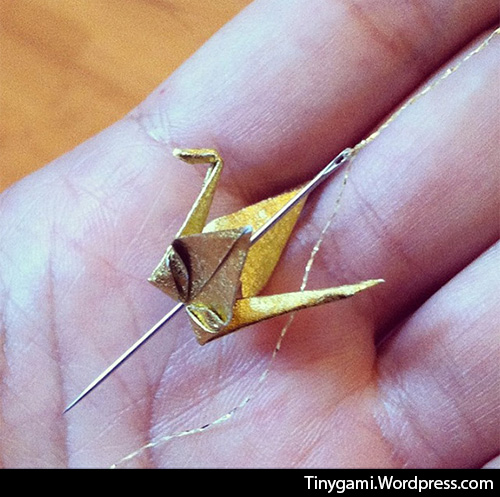
Question: How do you hang the cranes?
Answer: I use very small sewing needles to string the cranes. Usually they are “sharps” or “betweens.” For the smallest 1/4″ high cranes I use the thinnest beading needles I can find. I like to thread the cranes from the top to bottom of both each crane and each strand. This allows me to make certain no two matching papers are next to each other, meaning above or below vertically or side by side horizontally in neighboring strands.
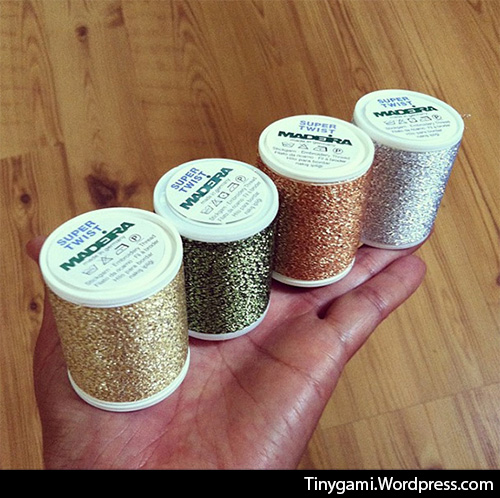
Question: What kind of thread do you use to hang them from?
Answer: My favorite is Madeira’s Supertwist metallic blend embroidery thread. It is more soft, flexible, delicate and shimmering than other metallic threads I’ve found at most fabric and craft stores. I order it online and have it shipped out to me.
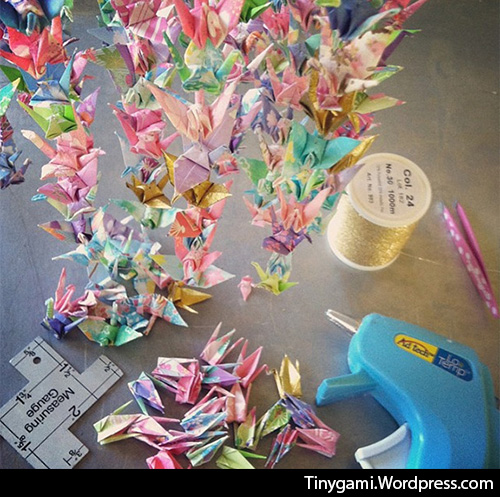
Question: How are the cranes suspended on the thread?
Answer: In 2016 while preparing my ArtPrize entry I discovered a new way to hang cranes (and frogs and rabbbits) using no glue. Going forward I will use this technique whenever possible including for the individual strands I offer in my Etsy shop. The process may take longer but I love that it allows me to hang strands even when there is no electricity (that I used to need to run a mini glue gun).
Previously I used a low-melt temperature glue gun to hang each crane to the thread. High-melt will burn straight through the thread. The seam allowance tool in the lower left corner is to make sure each crane has the same amount of space between them to keep the length of each strand uniform. The tweezers I use to pull glue off/out of a crane that didn’t attach to the thread in the correct direction, meaning no two cranes hang facing the same direction as the cranes above or below them. I also try to set them at different angles to the cranes that surround them on each side.
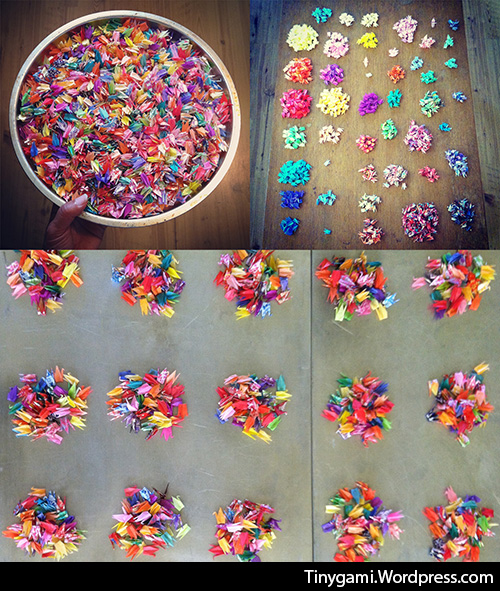
Question: How do you decide where the colors go?
Answer: It takes far longer to prepare the cranes for hanging than most people realize. The process begins by dividing out the 1000 cranes into piles of matching patterns and solid colors. Once that’s done I divide the cranes by pattern and color into equal piles. Each pile represents one strand. There are never even numbers of anything so after following simple division it becomes more intuitive dividing them out in a way where colors or patterns are as evenly dispersed as possible so the overall color scheme will be balanced from strand to strand.

Once the cranes are divided into equal piles of mixed colors and patterns I drop them into small circles made of paper to keep them from mixing together until they’re hung.
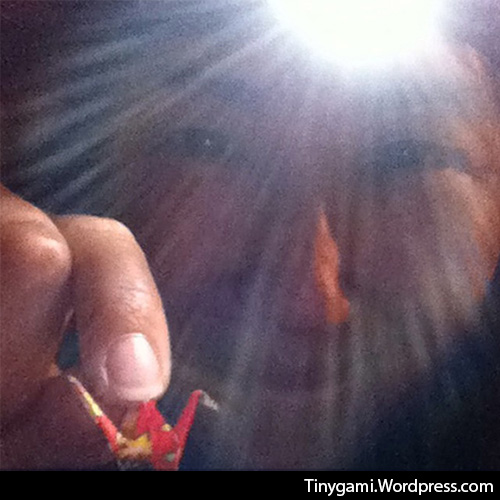
Question: How is your vision?
Answer: Honestly? Not as good as it used to be. I now need reading glasses and good light. They’re both crucial when working in miniature formats whether using a swing arm lamp, natural light or sometimes at night I often use my camping headlamp in the house. Clear, bright light is imperative for me to be able to see as clearly as possible when folding the tiniest of cranes. For the headlamp I do use rechargeable batteries in an effort to be as eco-friendly as possible.
Question: Are you worried about arthritis? Carpal Tunnel Syndrome? Do your fingers hurt? Do your hands hurt?
Answer: No. No. No. No. But, I do worry about tendonitis as my right forearm will get sore if I fold thick or soft paper or very tiny small folds (think frog legs and feet) for too long. Then I have to take frequent breaks and stretch out the tendon that gets stressed by putting my art out to my side at a 90º angle to my body and bending my wrist upward so that my hand is at a 90º angle to the arm (now parallel to my body). It’s a little trick a Physical Therapist told me about at ArtPrize that has done wonders to reduce the strain in my forearm.
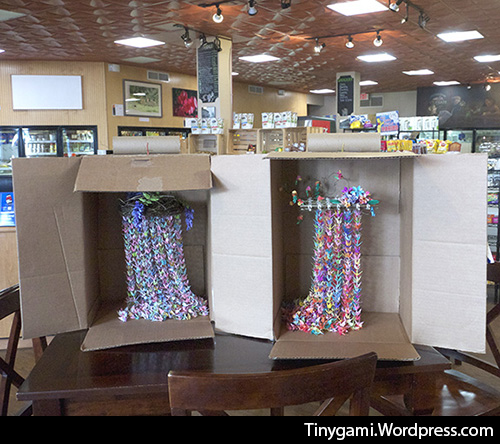
Question: How do you transport the cranes from your home to a venue?
Answer: It isn’t terribly elegant but to protect them from light, dust, weather, and general damage I use customized cardboard boxes. The trick is adding a cardboard tube at the top to roll the monofilament they hang from onto to keep it from tangling during transport. The strands of cranes can puddle in the bottom of the boxes. My main goal is to keep the structure from crushing the paper cranes. This protects the structure from damage as well and is how I store the mobiles when they aren’t on display.
In 2015 I came up with an alternative, but similar, method to transport the mobiles to my ArtPrize venue using plastic garbage cans. If it rains I can simply pop a plastic kitchen garbage bag over the entire container. It’s not as protective but is easier and faster to get the mobiles in and take them out and allows the strands to hang longer during transport.
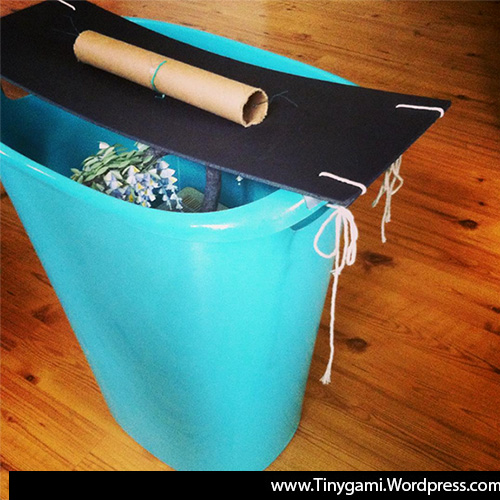
Question: How long have you been folding tiny cranes into mobiles this way?
Answer: Since 1995 but for the first 19 years they were pretty much a hidden hobby. ArtPrize in 2014 changed all of that and I am now busy creating a business model that will allow me to pursue my art as my full-time career both while at home and on the road traveling in my tiny trailer 🙂
Stacie: I am amazed at your creativity, gift of design and selecting what becomes a feast for the eyes. Your dexterity, skill and dedication as an artist nothing short of remarkable!
I hope your business plan enjoys the support of those equally gifted in that area. I cannot help but think that you ought to be able to make a comfortable living doing this.
All the best,
Fred
LikeLike
Thank you for your continued support and encouragement Fred. I truly appreciate it. Here’s hoping 2016 is a great year to launch my new business 🙂
LikeLike
I know so much time and love goes into your work. Best of luck turning it into a career.
What online sites have you bought paper from?
LikeLike
Hi Russell,
Apologies for the very tardy response! I’ve purchased from Kim’s Crane and The Origami Paper Shop.
LikeLike